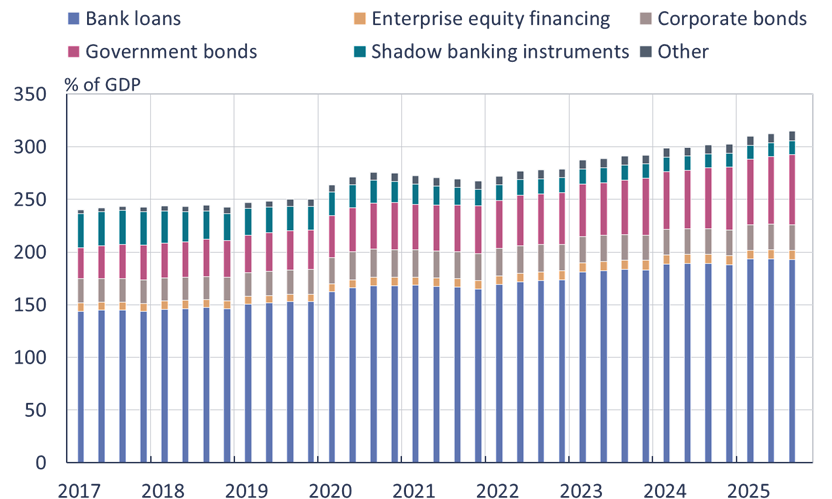BOFIT Weekly Review 44/2025
Local government borrowing drives growth in China’s aggregate financing
The People’s Bank of China (PBoC) reported that aggregate financing to the real economy (AFRE), a broad measure of domestic credit and liquidity extended to non-financial corporations, households, and the public sector, amounted to 437.08 trillion yuan ($61.36 trillion), or 315 % of GDP at the end of September. The on-year increase in the AFRE was 8.7 %. Bank loans overwhelmingly represent the largest aggregate financing item, even if growth in the stock of bank loans has slowed. As of end-September, the stock of bank loans was up 6.5 % y-o-y. Highest growth (20.2 % y-o-y) was in government borrowing, an item that includes the debt issues of central and local governments. Government borrowing in total came to 92.55 trillion yuan.
Local governments account by far the largest share of government debt. During January-September, local governments issued bonds totalling 8.546 trillion yuan, of which 4.362 trillion yuan were new issues, and 4.184 trillion yuan were refinancing of existing bonds. A large part of the new issues were special purpose bonds (3.686 trillion yuan) that are targeted at financing major projects. In recent years, local government special purpose bonds have also been permitted to finance activities such as covering the off-balance debts, settling unpaid invoices accrued after the Covid-19 pandemic and recapitalising small regional financial institutions. The economic magazine Caixin estimates that the unpaid bills of local governments total roughly 4.5 trillion yuan (3 % of GDP), and noted that the government programme calls for settling the unpaid debt by summer 2027.
As of 2023, part of special purpose bonds have been earmarked for paying down high-interest hidden debt of local governments that was acquired through the use of off-budget local government financing vehicles (LGFVs). According to central bank governor Pan Gongsheng, the refinancing programme has successfully reduced the number of LGFVs by over 70 % and decreased their overall indebtedness by over 60 % compared to 2023. China’s official estimate of the amount of hidden debt held by local governments, however, is a small fraction of most international estimates (BOFIT Weekly 46/2024). LGFVs also continue to issue new debt. Bloomberg reports that LGFVs have issued a total of $580 billion in bonds (domestic and international) in the first 10 months of this year, or somewhat less than in the same period in previous years. Significant proportion (80 %) of funds raised from the issues went to refinancing or repaying existing debt.
China’s finance ministry said this month that it will increase this year’s loan quota for local governments by 500 billion yuan (0.4 % of GDP) with the funds planned to support major investment projects. The central government, on broader concerns about the slowdown in investment growth, launched a new financing programme in September aimed at encouraging investment via the country’s three main policy banks. The 500 billion yuan allocated for the programme is intended to be supplemented by financing from commercial banks and private investors. The programme got off to a blazing start, with Caixin reporting that the policy banks distributed 300 billion yuan to investment projects in a two-week period in October. All of the remaining funds should be distributed by the end of this year. The programme targets high-tech innovations involving e.g. the digital economy, artificial intelligence or the green transition. Other branches eligible for funding still include transport and logistics, as well as industrial parks. The first project funded was the Wuxi-Yixing intercity railway.
China’s domestic aggregate financing stock in relation to the size of the economy continues to increase steadily

Sources: People’s Bank of China, Macrobond and BOFIT.